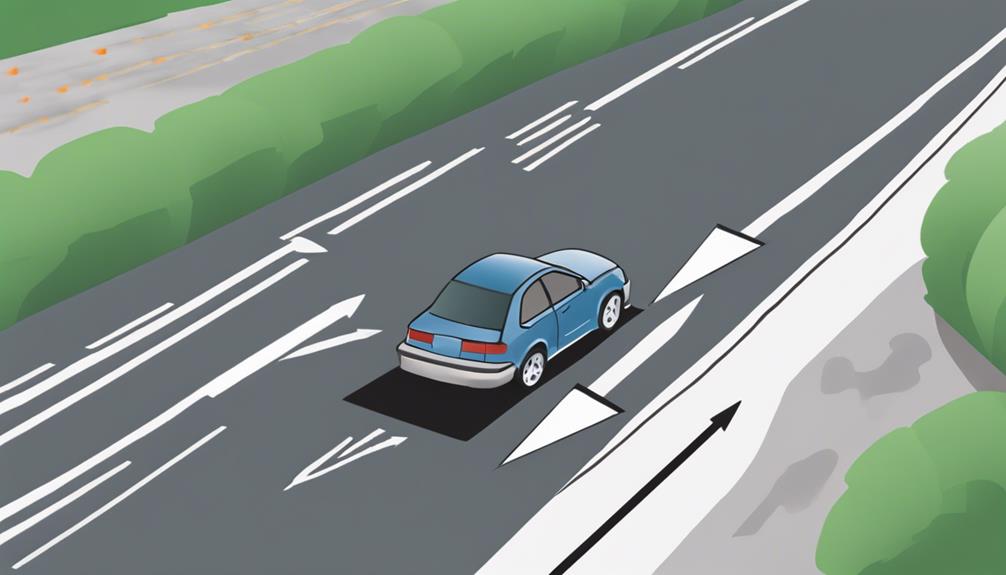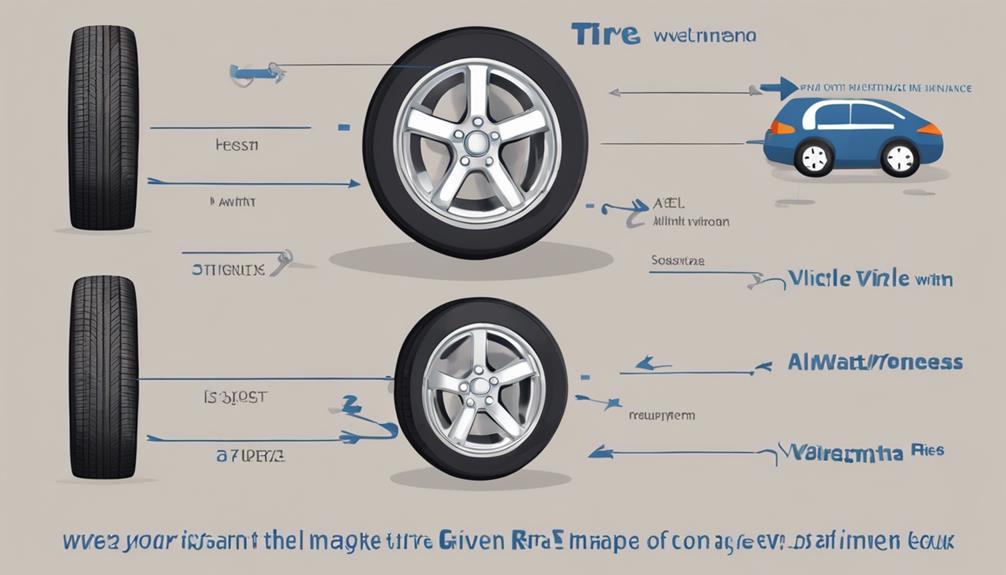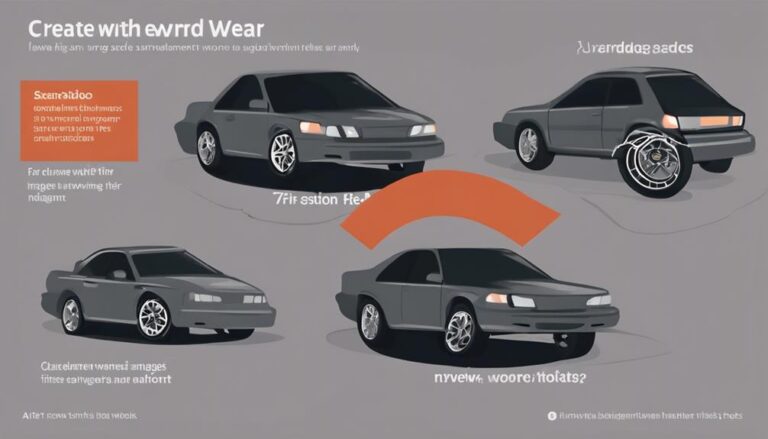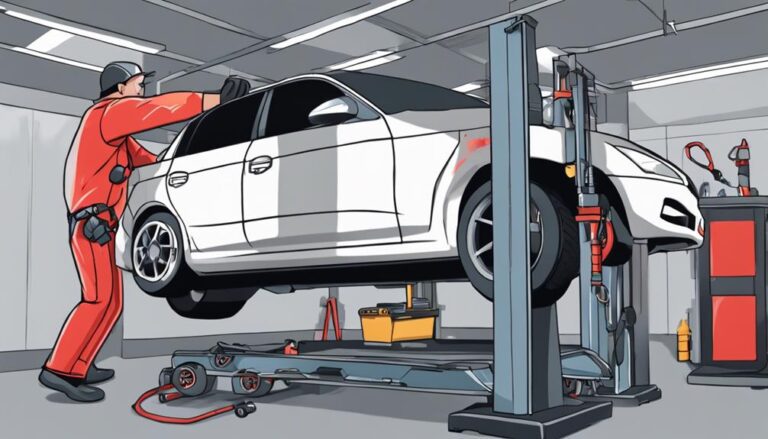Indications for Tire Rotation and Alignment Maintenance
You might not realize that tire rotation and alignment maintenance play a key role in keeping your vehicle operating smoothly.
But did you know that there are specific indications that can signal the need for these essential services?
Understanding these signs can help you detect issues early on, potentially saving you from costly repairs down the road.
So, what are these indicators, and how can they impact your driving experience?
Let's explore the subtle yet significant cues that your vehicle might be giving you, hinting at the need for tire rotation and alignment maintenance.
Key Takeaways
- Regular maintenance prevents tire wear and vibrations, ensuring a smooth driving experience.
- Proper alignment enhances safety, traction, and overall vehicle performance.
- Tire rotation minimizes road noise and maintains tread pattern for quieter driving.
- Addressing handling issues promptly through alignment improves control, steering response, and driving comfort.
Signs of Uneven Tire Wear
To identify signs of uneven tire wear, carefully inspect the tread depth variations across your tires. Tread depth is crucial in determining the condition of your tires. Uneven wear patterns can indicate issues with tire pressure, alignment, or suspension components.
Start by examining each tire's tread depth using a tread depth gauge. Variances in tread depth between tires or within the same tire can signal uneven wear. Look for wear patterns such as cupping, feathering, or camber wear that can provide insight into potential underlying problems.
Cupping appears as spots of uneven wear around the tire, often caused by suspension issues. Feathering occurs when the tread ribs wear down unevenly, possibly due to misalignment. Camber wear is when the tire tilts in or out, leading to wear on the inside or outside edge of the tire.
Vibrations While Driving
Inspect your vehicle for vibrations while driving as they may indicate underlying issues with tire balance or alignment. Imbalanced tires can disrupt the smooth rotation of the wheels, causing vibrations that are felt through the steering wheel or even the entire vehicle. These vibrations can impact your driving comfort and signal the need for maintenance. Addressing tire balance problems promptly is crucial to prevent further damage and ensure a safe driving experience. The table below highlights how tire balance affects driving comfort:
| Aspect | Impact | Solution |
|---|---|---|
| Uneven tire balance | Vibrations at various speeds | Tire rotation |
| Misaligned tires | Pulling to one side | Wheel alignment |
| Worn out tires | Increased road noise | Tire replacement |
Regular maintenance, including tire rotation and alignment, is essential to minimize vibrations and maintain a smoother ride. By addressing these issues promptly, you can enhance your driving experience while ensuring your vehicle's optimal performance.
Handling Issues on the Road

Experiencing handling issues on the road, such as vehicle pulling or drifting, signals the critical need for tire rotation and wheel alignment to restore balance and stability. Addressing these problems promptly is crucial for improved stability and driving comfort.
Here are four essential points to consider:
- Safety Concerns: Handling issues compromise your ability to control the vehicle, increasing safety risks for you and others on the road.
- Enhanced Performance: Proper tire rotation and alignment not only address handling issues but also optimize vehicle performance, ensuring a smoother drive.
- Steering Response: Restoring balance through alignment improves steering response, making your vehicle more predictable and easier to maneuver.
- Driving Comfort: By rectifying handling issues with rotation and alignment, you enhance driving comfort, reducing fatigue and stress during your journeys.
Maintaining your tires through regular rotation and alignment not only resolves handling issues but also contributes to a safer and more pleasant driving experience. Prioritizing these maintenance tasks will keep your vehicle performing at its best and ensure your safety on the road.
Excessive Road Noise
Excessive road noise often indicates underlying issues with tire wear and tread patterns, requiring attention to ensure a quieter driving experience. When your tires exhibit uneven wear and variations in tread patterns, the result is increased noise levels while driving. This noise can be bothersome and distracting, affecting your overall driving comfort.
To address this concern, prioritize regular tire maintenance, including rotation. By rotating your tires at recommended intervals, you can minimize uneven wear and promote more uniform tread patterns. This proactive approach not only enhances tire longevity but also contributes to noise reduction on the road.
Proper tire alignment is another key factor in reducing road noise. Misaligned tires can cause uneven wear, leading to increased noise levels during driving. By ensuring your tires are correctly aligned, you can help maintain even tread patterns and minimize excessive road noise. Remember, addressing tire maintenance issues promptly is crucial for a quieter and more enjoyable driving experience.
Importance of Tire Alignment

Proper tire alignment is essential for maintaining vehicle performance and ensuring safe driving conditions. When your tires are properly aligned, several benefits are achieved:
- Improved Performance: Correct alignment ensures that your vehicle travels straight without pulling to one side, enhancing overall performance.
- Extended Tire Lifespan: Proper alignment prevents uneven tire wear, extending the lifespan of your tires and saving you money in the long run.
- Enhanced Safety: Aligned tires provide better traction and handling, reducing the risk of accidents on the road.
- Prevention of Costly Repairs: Misaligned tires can lead to mechanical issues such as worn-out suspension components, which can be costly to repair. By maintaining proper alignment, you can avoid these expenses and keep your vehicle running smoothly.
Regular alignment checks, at least annually, are crucial for experiencing these benefits and ensuring a safe and enjoyable driving experience. By prioritizing tire alignment, you not only improve your vehicle's performance but also enhance safety on the road.
Frequently Asked Questions
How Can You Tell if You Need a Tire Rotation?
If your tires show uneven tread wear or you experience handling issues like drifting, reduced grip, or pulling, it's time for a rotation. Check tire pressure and look for signs of wear to ensure optimal performance.
How Often Should Tires Be Rotated and Aligned?
You should have your tires rotated every 5,000 to 8,000 miles to ensure even wear and extend their lifespan. Checking the wheel alignment annually is crucial for maintaining proper handling and preventing irregular tire wear.
How Do You Know When Your Tires Need an Alignment?
If you experience steering issues like pulling or vibrations, your tires may need alignment. Uneven wear affects tire lifespan. Check for irregular patterns. Keep an eye out for off-center steering or vibrations at speed.
Do I Need an Alignment Every Time I Change Tires?
When changing tires, aligning wheels each time isn't essential. However, aligning after tire replacement ensures optimal performance. Frequent checks prevent uneven tire wear and enhance safety. It's prudent to align wheels with new tires for better handling and longevity.
Conclusion
In conclusion, maintaining proper tire rotation and alignment is crucial for your vehicle's health and longevity. By addressing signs of uneven tire wear, vibrations while driving, handling issues on the road, and excessive road noise, you can ensure optimal performance and safety.
Remember, regular maintenance is key to preventing costly repairs and ensuring a smooth driving experience. So, don't wait – schedule your tire rotation and alignment today to keep your vehicle in top shape!







